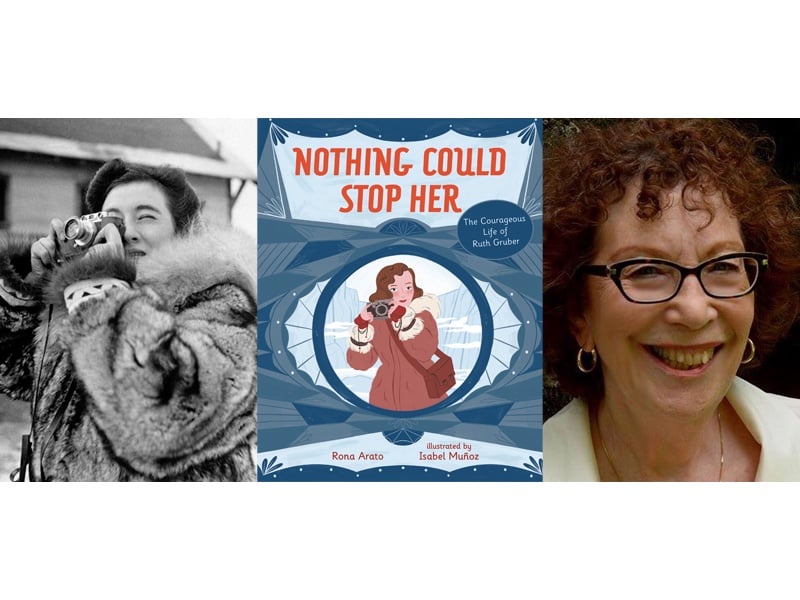It was while working on her book The Ship to Nowhere: On Board the Exodus (Second Story Press, 2016) that Rona Arato started reading about the extraordinary life of American journalist and activist Ruth Gruber.
That book is about the Exodus – the ship carrying 4,500 Jewish refugees from France that was turned away from Palestine in 1947. Ruth Gruber was the journalist who covered the story and followed the ship when it was sent back to Germany. “She appears in a few chapters and sidebars, but Gruber was such an interesting person that I wanted to do a separate book about her,” Arato says.
Arato’s fascination with Gruber is understandable. Her life is an incredible series of adventures, which were often very dangerous. In the era soon after American women had won the right to vote, Gruber entered university at age 15, and by age 20 had earned a PhD (a world record at the time). “When girls were expected to get married and have children, Gruber went her own way,” Arato says.
Her new book, a biography of Ruth Gruber for middle-grade readers, is aptly titled Nothing Could Stop Her: The Courageous Life of Ruth Gruber (Lerner Publishing, out now) – for nothing really could.
Even as Hitler rose to prominence, Gruber, who was Jewish, packed her bags and set off to Germany to pursue a fellowship at the University of Cologne in 1931. Despite the growing Nazi threat, she stayed to complete her PhD in just one year. To understand first-hand what was happening, she attended a Nazi rally by herself.
After finishing her PhD, Gruber returned to New York and began writing for newspapers. Not only did Gruber create awareness about social issues through her writing but also she actively pursued danger in her quest for truth and justice. “She was the first journalist of any nationality to be allowed into the Soviet Arctic to write about it. And this was during the Stalinist era,” Arato says.

Illustration: Isabel Muñoz
The fact that Gruber, who died at age 105 in 2016, wrote prolifically about her life and experiences made researching for Nothing Could Stop Her simultaneously convenient and overwhelming.
“Gruber documented everything. Everything in my book comes directly from her books. The quotes, the dialogue are all in her words,” Arato says. “I also did secondary research. For example, the weather in Siberia and Alaska when Gruber was there. I tried to recreate that atmosphere so that the child reading the book can feel they are there, too.”
While Arato’s book begins with Gruber as a child, the bulk of it is about her life as an adult. Arato devotes a significant portion to the most important assignment of Gruber’s life – when she was sent by the United States government to escort 1,000 Second World War refugees from Italy to a refugee camp in Oswego, New York.
To protect Gruber during the dangerous mission, she was sent to Italy in a military plane under the title of general. This meant, if captured, as a U.S. general she would have to be given food and shelter and kept alive according to the rules of the Geneva Convention. “She came back through U-boat infested waters,” marvels Arato.
A former school teacher, Rona Arato has written more than 20 books (fiction and nonfiction) for children, with a specific focus on human rights and anti-Semitism.
Through Gruber’s story, Arato wants people – especially young people – to know they can make a difference. “When I speak at schools, I always tell children, you can’t stop the war in Ukraine, but you can stop one in your classroom, in the schoolyard, on the playground,” she says. “If you see somebody being bullied because they are LGBTQ or a different race, you can be the one to stop it. You can be the one to befriend that person. You can be the one to stick up for an individual’s right to be whoever they are,” she says.
Nothing Could Stop Her ends Gruber’s story in 1945, with the Oswego refugees getting permission to stay in the United States. Arato summarizes Gruber’s life and adventures thereafter in a detailed afterword. “Unfortunately, I never got to meet her,” Arato says. “I wish I had. But I feel like I got to know her through working on this book.”
Credit: Ruth Gruber (left) and Rona Arato

 Contact us via email
Contact us via email
